spare wheel CHEVROLET EPICA 2005 1.G Owners Manual
[x] Cancel search | Manufacturer: CHEVROLET, Model Year: 2005, Model line: EPICA, Model: CHEVROLET EPICA 2005 1.GPages: 340, PDF Size: 2.19 MB
Page 204 of 340
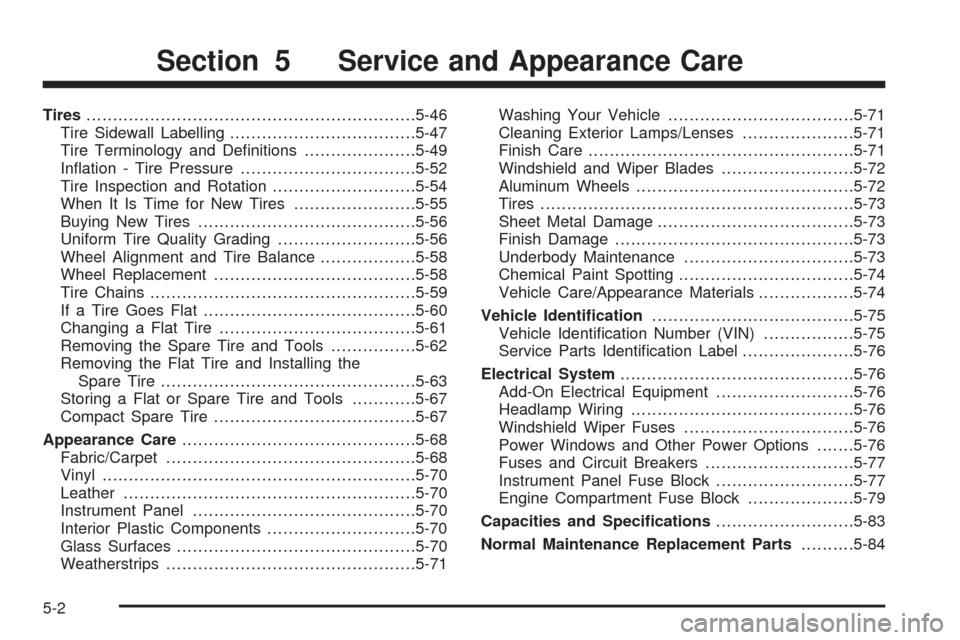
Tires..............................................................5-46
Tire Sidewall Labelling...................................5-47
Tire Terminology and Deļ¬nitions.....................5-49
Inļ¬ation - Tire Pressure.................................5-52
Tire Inspection and Rotation...........................5-54
When It Is Time for New Tires.......................5-55
Buying New Tires.........................................5-56
Uniform Tire Quality Grading..........................5-56
Wheel Alignment and Tire Balance..................5-58
Wheel Replacement......................................5-58
Tire Chains..................................................5-59
If a Tire Goes Flat........................................5-60
Changing a Flat Tire.....................................5-61
Removing the Spare Tire and Tools................5-62
Removing the Flat Tire and Installing the
Spare Tire................................................5-63
Storing a Flat or Spare Tire and Tools............5-67
Compact Spare Tire......................................5-67
Appearance Care............................................5-68
Fabric/Carpet...............................................5-68
Vinyl...........................................................5-70
Leather.......................................................5-70
Instrument Panel..........................................5-70
Interior Plastic Components............................5-70
Glass Surfaces.............................................5-70
Weatherstrips...............................................5-71Washing Your Vehicle...................................5-71
Cleaning Exterior Lamps/Lenses.....................5-71
Finish Care..................................................5-71
Windshield and Wiper Blades.........................5-72
Aluminum Wheels.........................................5-72
Tires...........................................................5-73
Sheet Metal Damage.....................................5-73
Finish Damage.............................................5-73
Underbody Maintenance................................5-73
Chemical Paint Spotting.................................5-74
Vehicle Care/Appearance Materials..................5-74
Vehicle Identi�cation......................................5-75
Vehicle Identiļ¬cation Number (VIN).................5-75
Service Parts Identiļ¬cation Label.....................5-76
Electrical System............................................5-76
Add-On Electrical Equipment..........................5-76
Headlamp Wiring..........................................5-76
Windshield Wiper Fuses................................5-76
Power Windows and Other Power Options.......5-76
Fuses and Circuit Breakers............................5-77
Instrument Panel Fuse Block..........................5-77
Engine Compartment Fuse Block....................5-79
Capacities and Speci�cations..........................5-83
Normal Maintenance Replacement Parts..........5-84
Section 5 Service and Appearance Care
5-2
Page 256 of 340
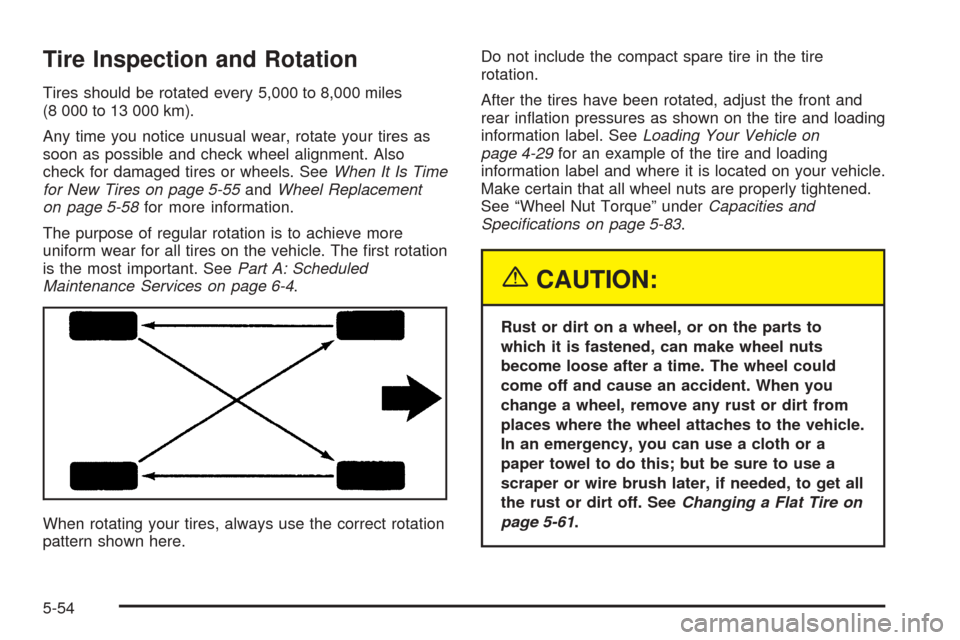
Tire Inspection and Rotation
Tires should be rotated every 5,000 to 8,000 miles
(8 000 to 13 000 km).
Any time you notice unusual wear, rotate your tires as
soon as possible and check wheel alignment. Also
check for damaged tires or wheels. SeeWhen It Is Time
for New Tires on page 5-55andWheel Replacement
on page 5-58for more information.
The purpose of regular rotation is to achieve more
uniform wear for all tires on the vehicle. The ļ¬rst rotation
is the most important. SeePart A: Scheduled
Maintenance Services on page 6-4.
When rotating your tires, always use the correct rotation
pattern shown here.Do not include the compact spare tire in the tire
rotation.
After the tires have been rotated, adjust the front and
rear inļ¬ation pressures as shown on the tire and loading
information label. SeeLoading Your Vehicle on
page 4-29for an example of the tire and loading
information label and where it is located on your vehicle.
Make certain that all wheel nuts are properly tightened.
See āWheel Nut Torqueā underCapacities and
Speciļ¬cations on page 5-83.
{CAUTION:
Rust or dirt on a wheel, or on the parts to
which it is fastened, can make wheel nuts
become loose after a time. The wheel could
come off and cause an accident. When you
change a wheel, remove any rust or dirt from
places where the wheel attaches to the vehicle.
In an emergency, you can use a cloth or a
paper towel to do this; but be sure to use a
scraper or wire brush later, if needed, to get all
the rust or dirt off. SeeChanging a Flat Tire on
page 5-61.
5-54
Page 258 of 340

Buying New Tires
To ļ¬nd out what kind and size of tires you need, look at
the tire and loading information label attached to your
vehicle. SeeLoading Your Vehicle on page 4-29
for a label example and where it is attached to your
vehicle.
Make sure the replacements are the same size,
load range, speed rating and construction type
(bias, bias-belted or radial) as your original tires.
{CAUTION:
Mixing tires could cause you to lose control
while driving. If you mix tires of different sizes
or types (radial and bias-belted tires), the
vehicle may not handle properly, and you
could have a crash. Using tires of different
sizes may also cause damage to your vehicle.
Be sure to use the same size and type tires on
all wheels. Itās all right to drive with your
compact spare temporarily, it was developed
for use on your vehicle. SeeCompact Spare
Tire on page 5-67.
{CAUTION:
If you use bias-ply tires on your vehicle, the
wheel rim �anges could develop cracks after
many miles of driving. A tire and/or wheel
could fail suddenly, causing a crash. Use only
radial-ply tires with the wheels on your vehicle.
Uniform Tire Quality Grading
Quality grades can be found where applicable on the
tire sidewall between tread shoulder and maximum
selection width. For example:
5-56
Page 264 of 340

Removing the Spare Tire and Tools
The spare tire and tools you will need are located in
the trunk.
A. Jack
B. Wheel Wrench
C. Jack Handle
D. Screwdriver1. Open the trunk. SeeTrunk on page 2-10for more
information.
2. Lift and remove the trim cover.
3. Turn the retainer on
the spare tire
counterclockwise and
remove the retainer.
4. Remove the compact spare tire. SeeCompact
Spare Tire on page 5-67for more information.
5. Remove the jack, the jack handle and the wheel
wrench. Your vehicleās jack is stored in a foam
tray in the left side of the trunk. The tools are stored
in a bag in the trunk near the spare tire.
5-62
Page 265 of 340

Removing the Flat Tire and
Installing the Spare Tire
1. If your vehicle has wheel covers, loosen the four
plastic caps by hand or by using the wheel
wrench. The plastic nuts do not come off.
2. Remove the wheel cover using the ļ¬at end of the
jack handle or the screwdriver. Pry along the edge
of the wheel cover until it comes off.
3. Use the wheel wrench to loosen all the wheel nuts.
Do not remove them yet.4. Locate the notch in the frame near each wheel
which the jack head ļ¬ts in.
5. Position the jack and raise the jack head until it ļ¬ts
ļ¬rmly into the notch in the vehicleās frame nearest
the ļ¬at tire.
6. Put the compact spare tire near you.
5-63
Page 266 of 340
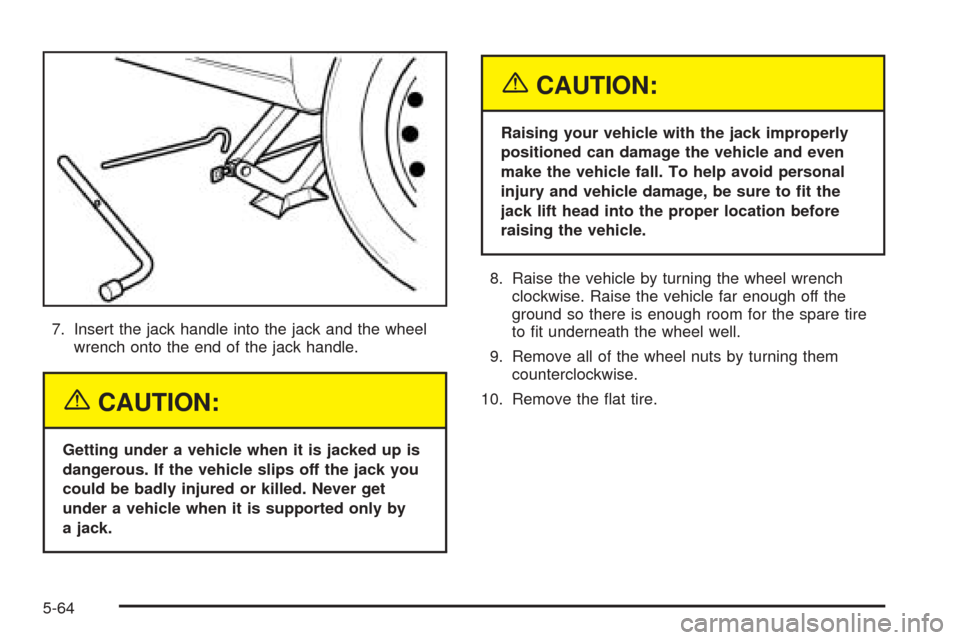
7. Insert the jack handle into the jack and the wheel
wrench onto the end of the jack handle.
{CAUTION:
Getting under a vehicle when it is jacked up is
dangerous. If the vehicle slips off the jack you
could be badly injured or killed. Never get
under a vehicle when it is supported only by
a jack.
{CAUTION:
Raising your vehicle with the jack improperly
positioned can damage the vehicle and even
make the vehicle fall. To help avoid personal
injury and vehicle damage, be sure to �t the
jack lift head into the proper location before
raising the vehicle.
8. Raise the vehicle by turning the wheel wrench
clockwise. Raise the vehicle far enough off the
ground so there is enough room for the spare tire
to ļ¬t underneath the wheel well.
9. Remove all of the wheel nuts by turning them
counterclockwise.
10. Remove the ļ¬at tire.
5-64
Page 267 of 340

{CAUTION:
Rust or dirt on the wheel, or on the parts to
which it is fastened, can make the wheel nuts
become loose after a time. The wheel could
come off and cause an accident. When you
change a wheel, remove any rust or dirt from
the places where the wheel attaches to the
vehicle. In an emergency, you can use a cloth
or a paper towel to do this; but be sure to use
a scraper or wire brush later, if you need to, to
get all the rust or dirt off.11. Remove any rust or dirt
from the wheel bolts,
mounting surfaces
and spare wheel.
12. Place the compact spare tire on the wheel-mounting
surface.
{CAUTION:
Never use oil or grease on studs or nuts. If
you do, the nuts might come loose. Your wheel
could fall off, causing a serious accident.
13. Install the wheel nuts with the rounded end of the
nuts toward the wheel. Tighten each nut by hand
clockwise until the wheel is held against the hub.
5-65
Page 269 of 340

Storing a Flat or Spare Tire
and Tools
{CAUTION:
Storing a jack, a tire, or other equipment in the
passenger compartment of the vehicle could
cause injury. In a sudden stop or collision,
loose equipment could strike someone. Store
all these in the proper place.
To store a ļ¬at or compact spare tire and tools, do the
following:
1. Store the ļ¬at or compact spare tire in the spare tire
compartment.
2. Place the tire in the compartment, then secure the
retainer.
3. Store the jack in its foam tray in the trunk.
4. Store the tools securely in the trunk.
5. Replace the trim cover.
The compact spare tire is for temporary use only.
Replace the compact spare tire with a full-size tire as
soon as you can. SeeCompact Spare Tire on
page 5-67.
Compact Spare Tire
Although the compact spare tire was fully inļ¬ated when
your vehicle was new, it can lose air after a time.
Check the inļ¬ation pressure regularly. It should be
60 psi (420 kPa).
After installing the compact spare on your vehicle, you
should stop as soon as possible and make sure
your spare tire is correctly inļ¬ated. The compact spare
is made to perform well at speeds up to 50 mph
(80 km/h), so you can ļ¬nish your trip and have your
full-size tire repaired or replaced where you want.
Of course, it is best to replace your spare with a full-size
tire as soon as you can. Your spare will last longer
and be in good shape in case you need it again.
Notice:When the compact spare is installed, do
not take your vehicle through an automatic car wash
with guide rails. The compact spare can get
caught on the rails. That can damage the tire and
wheel, and maybe other parts of your vehicle.
Do not use your compact spare on other vehicles.
And do not mix your compact spare tire or wheel with
other wheels or tires. They will not ļ¬t. Keep your
spare tire and its wheel together.
Notice:Tire chains will not �t your compact spare.
Using them can damage your vehicle and can
damage the chains too. Do not use tire chains on
your compact spare.
5-67
Page 331 of 340
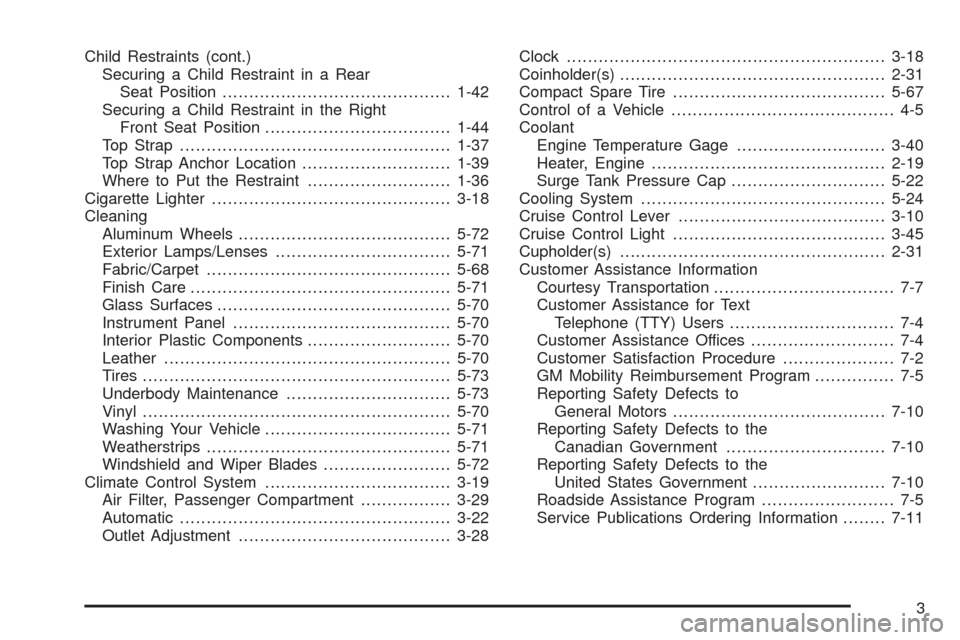
Child Restraints (cont.)
Securing a Child Restraint in a Rear
Seat Position...........................................1-42
Securing a Child Restraint in the Right
Front Seat Position...................................1-44
Top Strap...................................................1-37
Top Strap Anchor Location............................1-39
Where to Put the Restraint...........................1-36
Cigarette Lighter.............................................3-18
Cleaning
Aluminum Wheels........................................5-72
Exterior Lamps/Lenses.................................5-71
Fabric/Carpet..............................................5-68
Finish Care.................................................5-71
Glass Surfaces............................................5-70
Instrument Panel.........................................5-70
Interior Plastic Components...........................5-70
Leather......................................................5-70
Tires..........................................................5-73
Underbody Maintenance...............................5-73
Vinyl..........................................................5-70
Washing Your Vehicle...................................5-71
Weatherstrips..............................................5-71
Windshield and Wiper Blades........................5-72
Climate Control System...................................3-19
Air Filter, Passenger Compartment.................3-29
Automatic...................................................3-22
Outlet Adjustment........................................3-28Clock............................................................3-18
Coinholder(s)..................................................2-31
Compact Spare Tire........................................5-67
Control of a Vehicle.......................................... 4-5
Coolant
Engine Temperature Gage............................3-40
Heater, Engine............................................2-19
Surge Tank Pressure Cap.............................5-22
Cooling System..............................................5-24
Cruise Control Lever.......................................3-10
Cruise Control Light........................................3-45
Cupholder(s)..................................................2-31
Customer Assistance Information
Courtesy Transportation.................................. 7-7
Customer Assistance for Text
Telephone (TTY) Users............................... 7-4
Customer Assistance Offices........................... 7-4
Customer Satisfaction Procedure..................... 7-2
GM Mobility Reimbursement Program............... 7-5
Reporting Safety Defects to
General Motors........................................7-10
Reporting Safety Defects to the
Canadian Government..............................7-10
Reporting Safety Defects to the
United States Government.........................7-10
Roadside Assistance Program......................... 7-5
Service Publications Ordering Information........7-11
3
Page 338 of 340
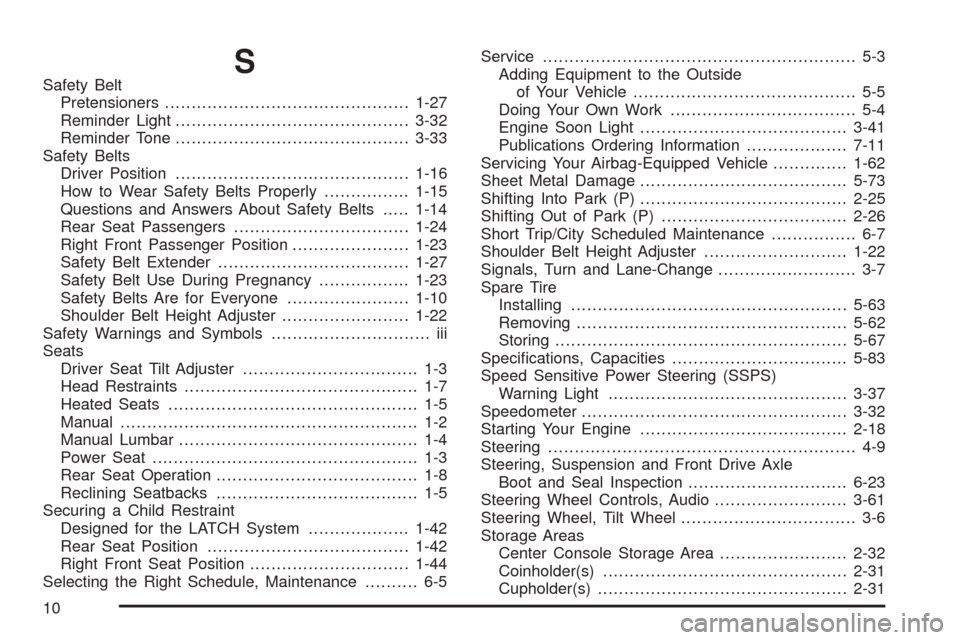
SSafety Belt
Pretensioners..............................................1-27
Reminder Light............................................3-32
Reminder Tone............................................3-33
Safety Belts
Driver Position............................................1-16
How to Wear Safety Belts Properly................1-15
Questions and Answers About Safety Belts.....1-14
Rear Seat Passengers.................................1-24
Right Front Passenger Position......................1-23
Safety Belt Extender....................................1-27
Safety Belt Use During Pregnancy.................1-23
Safety Belts Are for Everyone.......................1-10
Shoulder Belt Height Adjuster........................1-22
Safety Warnings and Symbols.............................. iii
Seats
Driver Seat Tilt Adjuster................................. 1-3
Head Restraints............................................ 1-7
Heated Seats............................................... 1-5
Manual........................................................ 1-2
Manual Lumbar............................................. 1-4
Power Seat.................................................. 1-3
Rear Seat Operation...................................... 1-8
Reclining Seatbacks...................................... 1-5
Securing a Child Restraint
Designed for the LATCH System...................1-42
Rear Seat Position......................................1-42
Right Front Seat Position..............................1-44
Selecting the Right Schedule, Maintenance.......... 6-5Service........................................................... 5-3
Adding Equipment to the Outside
of Your Vehicle.......................................... 5-5
Doing Your Own Work................................... 5-4
Engine Soon Light.......................................3-41
Publications Ordering Information...................7-11
Servicing Your Airbag-Equipped Vehicle..............1-62
Sheet Metal Damage.......................................5-73
Shifting Into Park (P).......................................2-25
Shifting Out of Park (P)...................................2-26
Short Trip/City Scheduled Maintenance................ 6-7
Shoulder Belt Height Adjuster...........................1-22
Signals, Turn and Lane-Change.......................... 3-7
Spare Tire
Installing....................................................5-63
Removing...................................................5-62
Storing.......................................................5-67
Speciļ¬cations, Capacities.................................5-83
Speed Sensitive Power Steering (SSPS)
Warning Light.............................................3-37
Speedometer..................................................3-32
Starting Your Engine.......................................2-18
Steering.......................................................... 4-9
Steering, Suspension and Front Drive Axle
Boot and Seal Inspection..............................6-23
Steering Wheel Controls, Audio.........................3-61
Steering Wheel, Tilt Wheel................................. 3-6
Storage Areas
Center Console Storage Area........................2-32
Coinholder(s)..............................................2-31
Cupholder(s)...............................................2-31
10